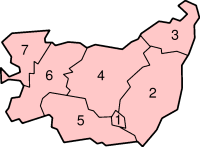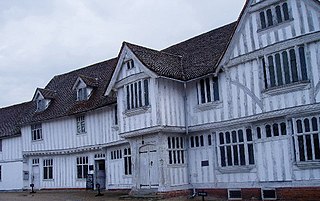
As of April 2006 there were 410 Grade I listed buildings in Suffolk, England. In the United Kingdom, the term listed building refers to a building or other structure officially designated as being of "exceptional architectural or historic special interest"; Grade I structures are those considered to be "buildings of "exceptional interest, sometimes considered to be internationally important. Just 2.5% of listed buildings are Grade I." The total number of listed buildings in England is 372,905. In England, the authority for listing under the Planning Act 1990 rests with English Heritage, a non-departmental public body sponsored by the Department for Culture, Media and Sport.

Ickworth is a small civil parish, almost coextensive with the estate of the National Trust's Ickworth House, in the West Suffolk district of Suffolk, eastern England, 2.3 miles (3.7 km) south-west of Bury St Edmunds. The population of the parish was only minimal at the 2011 Census and is included in the civil parish of Lawshall.

There are 12 Grade I listed buildings in Forest Heath, a non-metropolitan district of Suffolk, England.

There are many Grade I listed buildings in the East Suffolk District, a district formed in 2019 from a merge of Suffolk Coastal and Waveney. There are 60 such buildings from Suffolk Coastal, and 51 from Waveney.

Flixton Road Mill is a tower mill at Bungay, Suffolk, England which has been truncated and converted to residential accommodation. The structure is a Grade II listed building.

There are many Grade I listed buildings in Babergh, a non-metropolitan district of in the county of Suffolk in England.

There are many Grade I listed buildings in Mid Suffolk, a non-metropolitan district of in the county of Suffolk in England.

There are many Grade I listed buildings in St Edmundsbury, a former non-metropolitan district and borough in the county of Suffolk in England that takes its name from the town of Bury St Edmunds.

There are 42 Grade I listed buildings in Maidstone. The Borough of Maidstone is a local government district in the English county of Kent. The district covers a largely rural area of 152 square miles (394 km2) between the North Downs and the Weald with the town of Maidstone, the county town of Kent, in the north-west. The district has a population of approximately 166,400 in 2016.

Merseyside is a metropolitan county in North West England. It was created by the Local Government Act 1972, and consists of the metropolitan boroughs of Knowsley, St Helens, Sefton, Wirral, and the city of Liverpool. Buildings are listed on the recommendation of English Heritage to the Secretary of State for Culture, Media and Sport, who makes the decision whether or not to list the structure. Grade I listed buildings are defined as being of "exceptional interest, sometimes considered to be internationally important"; only 2.5 per cent of listed buildings are included in this grade. This is a complete list of Grade I listed churches in the metropolitan county of Merseyside as recorded in the National Heritage List for England.

Lancashire is a county in North West England. In 1974 parts of the historic county were divided between Greater Manchester, Merseyside, Cheshire and Cumbria, and part of the West Riding of Yorkshire was transferred into the county, creating the non-metropolitan county of Lancashire. Together with the unitary authorities of Blackburn with Darwen and Blackpool it now forms the ceremonial county of Lancashire.

St Mary's is an Anglican church in Hadleigh, Suffolk. It is an active parish church in the Diocese of St Edmundsbury and Ipswich and the archdeaconry of Ipswich. Its earliest parts date from medieval times, the church is a Grade I listed building.

There are 48 Grade I listed buildings in Greater Manchester, England. In the United Kingdom, the term listed building refers to a building or other structure officially designated as being of special architectural, historical or cultural significance; Grade I structures are those considered to be "buildings of exceptional interest". In England, the authority for listing under the Planning Act 1990 rests with Historic England, a non-departmental public body sponsored by the Department for Culture, Media and Sport.
There are over 20,000 Grade II* listed buildings in England. This page is a list of these buildings in the district of Babergh in Suffolk.
There are over 9,000 Grade I listed buildings in England. This page is a list of these buildings in the Craven District of North Yorkshire.
There are over 20,000 Grade II* listed buildings in England. This page is a list of these buildings in the unitary authority of Cheshire East.
There are over 9,000 Grade I listed buildings in England. This page is a list of these buildings in the unitary authority of Cheshire East.

Lavenham Guildhall is a timber-framed municipal building in Lavenham, Suffolk, England. It is Grade I listed.

























